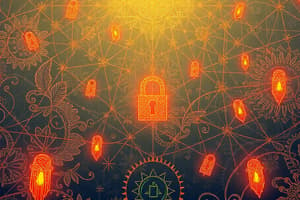Podcast
Questions and Answers
What aspect of security involves protecting assets from intentional or accidental damage, theft, or disclosure?
What aspect of security involves protecting assets from intentional or accidental damage, theft, or disclosure?
- Data security
- Cybersecurity
- Network security
- Physical security (correct)
Which technology is commonly used for securing electronic communication systems from unauthorized access?
Which technology is commonly used for securing electronic communication systems from unauthorized access?
- Intrusion Detection Systems (IDS)
- Safe use of IoT devices
- Virtual Private Network (VPN) (correct)
- Firewall configuration
What type of threats does cybersecurity primarily focus on protecting against?
What type of threats does cybersecurity primarily focus on protecting against?
- Natural disasters
- Physical theft
- Human errors
- Unauthorized access (correct)
Which security subtopic is directly related to the protection of information from unauthorized access?
Which security subtopic is directly related to the protection of information from unauthorized access?
What is a key aspect of network security that involves monitoring and detecting potential threats in real-time?
What is a key aspect of network security that involves monitoring and detecting potential threats in real-time?
Which aspect of security involves safeguarding networks against denial of service attacks?
Which aspect of security involves safeguarding networks against denial of service attacks?
What is a crucial element of cybersecurity to prevent unauthorized access to digital information?
What is a crucial element of cybersecurity to prevent unauthorized access to digital information?
Which practice ensures the confidentiality, integrity, and availability of data in data security?
Which practice ensures the confidentiality, integrity, and availability of data in data security?
What is a common measure in physical security to protect personnel and assets from threats such as theft?
What is a common measure in physical security to protect personnel and assets from threats such as theft?
Which aspect is covered by information security but not by cybersecurity?
Which aspect is covered by information security but not by cybersecurity?
What is a critical element of cybersecurity that involves adding an extra layer of security beyond passwords?
What is a critical element of cybersecurity that involves adding an extra layer of security beyond passwords?
Which practice in data security helps in preventing unauthorized access to sensitive information?
Which practice in data security helps in preventing unauthorized access to sensitive information?
Flashcards are hidden until you start studying
Study Notes
Security
Security is a critical aspect of maintaining the integrity, confidentiality, and availability of information in both personal and professional settings. It involves protecting assets from intentional or accidental damage, theft, or disclosure through various means, including technology, policies, and physical measures. In this article, we will explore the following subtopics related to security:
- Network security
- Cybersecurity
- Information security
- Physical security
- Data security
Network Security
Network security refers to the implementation of protocols and technologies designed to protect networks and electronic communication systems from unauthorized access, misuse, or denial of service. Key aspects of network security include:
- Firewall configuration
- Virtual Private Network (VPN) usage
- Intrusion Detection Systems (IDS)
- Secure Access Service Edge (SASE) deployment
- Implementation of Zero Trust security models
- Endpoint management
- Safe use of Internet of Things (IoT) devices
- Hybrid security solutions
Cybersecurity
Cybersecurity focuses on securing computer systems, networks, and devices against digital threats such as malware, hacking attempts, phishing scams, and other forms of cybercrime. Critical elements of cybersecurity include:
- Regular software and operating system updates
- Use of antivirus and anti-malware software
- Strong password hygiene
- Multi-factor authentication (MFA) setup
- Email spam filtering
- Monitoring of network traffic for suspicious activity
- Training and education of users on cybersecurity best practices
Information Security
Information security refers to the protection of digital or non-digital information against unauthorized access, modification, or destruction. Key areas of information security include:
- Encryption of sensitive data
- Access controls
- Incident response plans
- Business continuity planning
- Retention and disposal of records
- Third-party vendor management
- Awareness and training programs
- Compliance with industry standards and regulations
Physical Security
Physical security encompasses the measures taken to safeguard personnel, property, and assets from threats such as theft, vandalism, natural disasters, and terrorism. Some essential physical security components include:
- Perimeter fencing and access control
- Closed Circuit Television (CCTV) installation
- Emergency response planning
- Environmental controls like fire suppression systems
- Locking mechanisms and alarm systems
Data Security
Data security focuses on ensuring the confidentiality, integrity, and availability of data throughout its lifecycle. Essential data security practices include:
- Encryption of data at rest and in transit
- Data loss prevention policies
- Redundancy and disaster recovery measures
- Regular backups and testing
- Employee training on data handling
Security is a constantly evolving field, requiring continuous evaluation and adaptation to address new threats and vulnerabilities. As technology advances, security measures must adapt accordingly to provide robust protection for individuals and organizations alike.
Studying That Suits You
Use AI to generate personalized quizzes and flashcards to suit your learning preferences.




